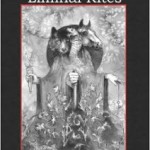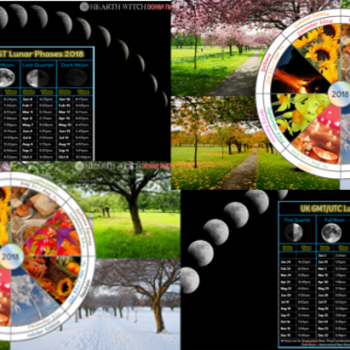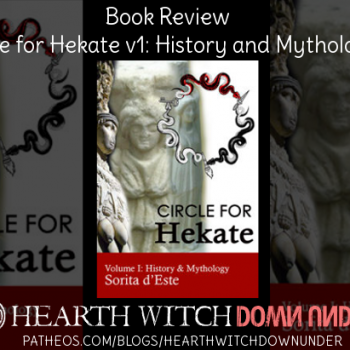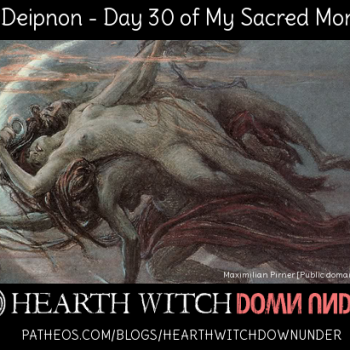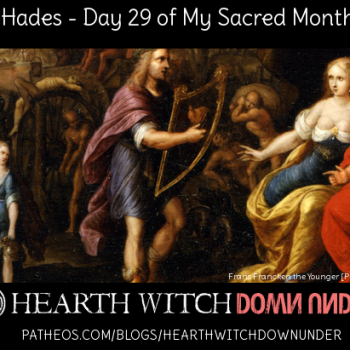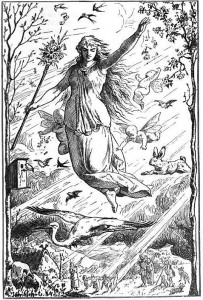
This piece was first published, by me, as a discussion on The Pagan Veil. I had planned to do a discussion like this for a while now, and Easter this year was the perfect time, when I was seeing more ridiculous memes than I usually would – including by non-Pagans. I couldn’t stand the idea of debunking the Easter memes on all those threads on Facebook, repeating myself a million times – and probably not making any difference anyway. So, discussion it became. And now reposting as a blog post, because, why not?
Here’s the usual message shared in the memes.
“Easter was originally the celebration of Ishtar, the Assyrian and Babylonian goddess of fertility and sex. Her symbols (like the egg and bunny) were and still are fertility and sex symbols (or did you actually think eggs and bunnies had anything to do with the resurrection?). After Constantine decided to Christianise the Empire, Easter was changed to represent Jesus. But at its roots, Easter (which is how you pronounce Ishtar) is all about celebrating fertility and sex.”
Ishtar was a Mesopotamian Goddess – Mesopotamia being, Assyria, Babylon, Akkadia, Sumeria (Inanna is her name in Sumeria, Astarte is her Aramaean name).
Symbols
Easter – bunnies, eggs, hares etc
Ishtar – The 8-pointed star, lions, dragons and Venus are her symbols. Hmmm, no eggs or bunnies.
Sex and Fertility
Easter – Through the symbolism of rabbits and eggs, yes.
Ishtar – A sex and fertility goddess (and war goddess).
Resurrection
Easter – Jesus. Do I need to tell you this myth?
Ishtar – Depends on the version you read. In some Ishtar/Inanna myths, she herself is the central figure of a resurrection after she was killed by “demons” in the Netherworld (underworld). In other myths she is the direct cause of her lover Tammuz/Dumuzis death, and, regretting it, goes about having him resurrected (this myth is very similar to the Egyptian Isis/Osiris myth).
Rome
Ishtar was not a Roman a goddess, though of course she would have had adherents in Rome, their number wasn’t very high at the time of the Anno Domini – the cultures and beliefs that formed Mesopotamia were rapidly declining at that point. Her cult was basically dead by the time of Constantine. The idea that the Christians would take a festival from a dying/dead religion is laughable – why would they do that? There are no converts in that.
Etymology & Pronunciation
Ishtar – is pronounced as it is written. Ish-tar. Not like Easter.
Easter – It’s origins are up for debate (much of it misinformed debate). According to the meme, it’s origin is “Ishtar,” according to Bede and the brothers Grimm, it’s origin is Eostre (see below). According to other sources it was an accident. Someone mistakenly wrote the Latin term “hebdomada alba” (white week) as High German “esostarum” – this later got shortened to Easter. As we do with nearly every word longer than three letters.
Passover – A Hebrew/Jewish festival observed in early-mid spring, much like Easter is. But, it is also the other name used for Easter, basically everywhere that English isn’t the native language. It’s etymology is clear.
Hebrew, Pesach.
Greek and Latin Pascha or Pasch. Psssst Latin = Roman.
Modern Spanish, Pascua and modern French, Paques.
I do wonder why the Romans would use “Easter” when they already used “Pascha.” Curious.
Ishtar Conclusion
Easter and Ishtar do have certain similarities – resurrection and fertility. But the rest? Nope. The Latin/Roman name for Easter is still in use, so why would the Romans/Christians create a new name from a dying or dead cult? Ishtar and Easter sound nothing alike. The symbols used in Easter are not Ishtars symbols.
Ishtar and Easter – have two similarities, but whether there is direct influence between the two is something that the evidence does not point to.
Eostre
“The Goddess Eostre was resurrected from death in spring her symbols were the Egg which represented rebirth and new life. Her other symbol was the rabbit or hare which represented fertility. The Goddess Eostre was known as Eastre in Norse, Ashtoreth in Greece and Astarte in Hebrew. The God Attis, Goddess Persephone and the Goddess Ishtar were also resurrected on this day. Easter is in effect the rebirth of the Sun (Son) in Spring.”
Note: Eostre is Anglo-Saxon. Ostara is Germanic. Eastre/Austra is Norse.
There is sadly little I can say about this one…. Because there is almost no information about her before Bede (672-735 CE/AD), a Christian monk, wrote about her. Kind of.
“Eosturmonath has a name which is now translated “Paschal month”, and which was once called after a goddess of theirs named Eostre, in whose honour feasts were celebrated in that month. Now they designate that Paschal season by her name, calling the joys of the new rite by the time-honoured name of the old observance.” – The Reckoning of Time.
After this the Brothers Grimm found his snippet of Eostre lore and wove it into their own folktales. Ostensibly they gathered more information about Ostara (German for Eostre) from actual people who still knew about her or followed her…. However, we already know the Grimms were not exactly the most trustworthy of historians. There is quite a bit of evidence that the Grimms falsified their folktales regarding Ostara – not least the multiple connections to various languages that make little to no sense at all.
Etymologically speaking, Eostre as a word could have existed – it would have meant something like “dawn.” The Grimms somehow connect the word to Latin “Auster” meaning “south wind” (because thats the direction the sun comes up… In Grimm-land). And they reasoned that, because there was an “Austri” in the Eddas, then there must too have been a female equivalent, “Austra” who, now magically existing, would be Ostara.
Proof! Eostre is real. Because of reasons.
Bede too is under suspicion of fabricating certain things he wrote about – one of which is the snippet about Eostre but also another deity, Hretha or Rheda, who was just as well known as Eostre was before he wrote about them. That being, not at all.
After all of this Eostre/Eastre/Ostara gets mentioned a few times by a few scholars and historians and the like. Oddly enough, nearly every mention of her includes things such as, “probably the hare was the sacred animal of Ostara,” K.A. Oberle, 1893. The key word there is “probably,” it comes up in multiple instances – as insightfully observed by the Domestic Witch. Until one day, it was no longer, “probably,” it was fact. Then more little stories and ideas are added to the “facts” and suddenly, there is an entire and full myth surrounding this goddess who maybe never existed.
Eostre Conclusion
The similarities between Eostre/Ostara and Easter are a lot. The veracity of the Eostre myths, are left wanting.
If you read the linked article by the Domestic Witch, the most telling thing is her conclusion. Pagans have been accusing the Christians of stealing Easter from us. When, in reality, it actually seems to be the other way around. She notes that there are historical sources for the eggs and rabbits (hares) as being part of Easter, and not any prior pagan belief.
Easter Conclusion
No one knows.
That’s the truth of the matter. No one knows how Easter started, when it started, where all of its symbols and traditions came from.
It IS possible that it draws from pagan traditions and beliefs. Of course it is possible.
It is also possible that it is mostly its own festival. It is likely that the timing of it is based around both the Jewish Passover dates (Jesus was said to be crucified during Passover) AND the fact that multiple pagan cultures celebrated the Spring Equinox.
It is possible that the modern Pagans stole Easter from the Christians, rather than the reverse we so often shout about.
It is possible that Eostre was a goddess of the Anglo-Saxons, or of some small regional tribe. It is possible there was never written information about her. It is possible.
It is possible that the Jesus resurrection myth is based on the Ishtar/Tammuz resurrection myth. Or even the Isis/Osiris myth. Or……
It is fact that it’s all stupid anyway.
No matter which festival started first, or who borrowed what belief and tradition from whom, Easter and Ostara are existing festivals and they aren’t going anywhere in the foreseeable future.
Eostres historical existence is irrelevant now. She may or may not have existed before Bede, but she has existed now for 1300 years. She is worshipped and honoured by a fairly significant number of modern Pagans. She has a myth now, no matter how old it is. She has a festival, she has traditions and symbols attached to her – no matter where they came from.
Eostre and Ostara exist now within Paganism, no matter their history. And does it matter if they came before or after Easter? Does it make the Equinox somehow less? Does it make the goddess less? Does it make the traditions you have been practising less?
In a modern context, none of it matters. It is not important.
In a historical context it does matter, but only insofar as we don’t keep lying to ourselves and others about our history and the history of our spiritual (or literal) ancestors. It is important we do not do a disservice to our community and make ourselves out to be liars and nothing more than anti-Christians.
We need to stop basing our legitimacy on Christianity, the interactions between ancient pagans and ancient Christians, and the falsity and villainy of Christianity.
Ostara is a festival celebrated by a large number of modern Pagans. It is celebrated in todays world. It exists now.
That’s what matters.
So maybe you should stop caring about Easter. And concentrate on the Ostara of today. Or whatever equivalent you happen to celebrate.
Tell your kids the myth about Eostre. Or Persephone. Or Ishtar. Or Isis and Osiris. Or Jesus.
Paint some eggs.
Cuddle some bunnies.
Eat some chocolate.
Plant some flowers (or pick some).
Celebrate spring.
And get over it.
Links and Sources
Debunking the Goddess of Easter pt1
Debunking the Goddess of Easter pt2
Eostre: The Making of a Myth
Eostre: The Making of a Myth pt2
Hunting the Spurious Eostre Hare
Easter Holidays
Bede, on Eostre

